
Amazon PPC 101: An Opportunity for E-Commerce Sellers (Plus a Free PPC Tool)

Table of Contents
- Why is PPC Important for Amazon Sellers?
- What is Amazon PPC?
- Here Are Four Ways to Take Advantage of Amazon’s Advertising Potential
- PPC Terminology 101
- This is the Point Where Many Amazon Product Launches are Won or Lost
- Who Can Use Amazon PPC Ads?
- What Are the Costs?
- Top Three Reasons to Try Amazon PPC
- How to Target the Most Critical PPC Metrics
- A Free Tool for Amazon Sellers
- Super Actionable Results
- Frequently Asked Questions
Amazon PPC: An Opportunity for E-Commerce Sellers
Fingers crossed, we’re coming to the end of the pandemic, and for e-commerce sellers, the conversation surrounding Pay Per Click (PPC) Amazon advertising campaigns no longer has to do with whether they’re being used.
Yes, they’re being used.
When we consider how to use PPC advertising on the Amazon marketplace, it’s just a question of how much.
Amazon PPC management is THE way to help make sure that buyers see your Amazon product in their search result.
Be sure to try out Helium 10’s Amazon PPC Software!
Why is PPC Important for Amazon Sellers?
Year after year, e-commerce and selling on Amazon have been increasing in popularity and importance. Now, the coronavirus pandemic has become a force multiplier.
It’s changed everything.
Amazon.com Ltd. reported soaring quarterly sales as quarantined buyers flooded it with sales. Amazon said that sales jumped 26% to 75.5 billion dollars (through March) compared to the previous year.
Because of that, the overall competitiveness of Amazon’s marketplace has reached new levels. That’s why using a well-conceived PPC campaign to create an Amazon ad group can help sellers play on what is becoming a very large stage.
If you were to imagine e-commerce and selling on Amazon as a sport, you could say that a solid PPC campaign structure gives you Olympic-level skills.
A healthy Amazon PPC campaign incrementally increases your product ranking, makes your product listing stand out, and brings in conversions that ultimately become your profits and captures buyers, not just viewers.
Vince Montero, Helium 10’s resident PPC expert and Senior Product Marketing Manager
Here’s what this post will cover:
- What is Amazon PPC?
- PPC terminology 101
- Who can use Amazon PPC ads?
- What are the costs?
- Top three reasons to try Amazon PPC
- How to target the most critical PPC metrics
- A free tool for Amazon sellers
What is Amazon PPC?
In the most simple terms, an Amazon PPC ad means that you are advertising on Amazon.
An Amazon PPC advertising campaign targets customer searches and products, and seeks to place an Amazon ad in a high-visibility placement.
To brand your products in the eyes of the shopper, you’ll want to target relevant, unbranded short to long tail keywords, and display your best-selling products in your ad so that shoppers who are interacting with your brand for the first time can see the best of what you have to offer.
After making a successful keyword bid, advertisers (sellers) pay a fee to Amazon when (during an Amazon search) a shopper clicks on ad that contains a relevant keyword. (That’s the pay-per-click).
Here Are Four Ways to Take Advantage of Amazon’s Advertising Potential
- An Amazon Sponsored Product ad is keyword-targeted, and allows advertisers to promote their individual products. They show up on shopping results and product detail pages. Within sponsored products, there are different ways to target search terms. Two of these ways are automatic-targeting and manual targeting. An automatic-targeting ad type focuses on keywords that Amazon’s algorithm has determined relates to your listing. A manual-targeting ad focuses on keywords or products that you’ve specified, allowing for customization and efficiency.
- An Amazon Sponsored Brand ad (formerly Headline Search Ads) represents keyword-targeted ads that feature a brand logo or product image, a custom headline, and up to three products. Available only to Brand Registered sellers, these ads appear above all search results to dramatically increase a sellers brand’s profile and discoverability.
- Sponsored Display ads make it easier for advertisers to reach their target audiences with ads that appear both on and off Amazon. Amazon says that Sponsored Display Ads are “a self-service advertising solution that gives advertisers the ability to launch display ad campaigns and reach relevant audiences quickly.”
- Amazon Stores are custom, stand-alone pages on Amazon that help individual brands tell their brand story and show off their products. You can send traffic to Stores by using Sponsored Brand ads. They require no website experience to use and are free.
PPC Terminology 101
Let’s get this out of the way first. We’re going to be indulging in PPC-speak. It may not require learning a complete new language, but there are a few terms that you’ll want to familiarize yourself with before we get started.
Targeting: When it comes time to set up your Amazon PPC campaign, you’ll choose to target your ads three different ways. You can focus on keywords, product ASINs, or Amazon categories.
Keyword Match Types: In determining how keyword matches on Amazon will occur, you can tailor your specific approach using three techniques. With a ‘Broad match,’ the search terms will reflect some or all parts of your keyword string (in any order). A ‘Phrase match’ does the same thing. However, the keyword string (or phrase) will be in the same order or sequence. Last, an ‘Exact match‘ will show results that duplicate the search terms word for word, in that exact order.
Negative Keyword: Negative matching using negative keywords, is a way that sellers on Amazon can tap their PPC ‘brake pedal’ to keep costs from getting out of control. It allows them to exclude unwanted search terms from their ad campaigns.
Automatic versus manual campaigns: Here’s Amazon’s four step guide to starting a PPC campaign:
- Set your campaign duration (or set no end date for an always-on campaign) and budget.
- Decide which keywords or products to target, or select automatic targeting to let Amazon match your ads to relevant search terms and products.
- Choose the products you want to advertise and set your bid.
- Launch your paid campaign.

This is the Point Where Many Amazon Product Launches are Won or Lost
Automatic campaigns are easy to understand and implement. It’s when you explore the manual keyword based campaigns that Amazon PPC becomes either scary science, or serious e-commerce voodoo.
Many Amazon sellers begin their PPC campaign with an automatic campaign. However, a manual campaign allows sellers more agility in controlling their ad spend and offers them the ability to react more quickly to the precise results that result. Ultimately, an ad campaign is often a mix of auto campaign and manual campaign strategies.
Dynamic Bidding: Amazon sellers can choose between fixed bids or Amazon’s dynamic bidding options which empowers Amazon to constantly adjust your bids based on the conversion probability.
Adjust Bids by Placement: This allows an advertiser to adjust their base bids from 0% to 900% for two placements: top of search (first page) and product pages.
Amazon ACoS (Advertising Cost of Sale): This is a crucial metric that measures the efficiency of your advertising campaign. It is the ratio of the amount of money you spend on advertising to the amount of money that results from those ads.
Amazon TACoS (Total Advertising Cost of Sale): This measures advertising spend relative to the total revenue generated. TACoS helps you to measure the long-term effects of advertising on the growth of your business.
Who Can Use Amazon PPC Ads?
- Amazon Sponsored Product ads are available for professional sellers, vendors, book vendors, Kindle Direct Publishing (KDP) authors, and agencies.
- Sponsored Brand ads are available for professional sellers enrolled in Amazon Brand Registry, vendors, book vendors, and agencies.
- Sponsored Display ads are available to professional sellers enrolled in Amazon Brand Registry, vendors, and agencies with clients who sell products on Amazon.
- Amazon Stores are available for sellers enrolled in Amazon Brand Registry, vendors, and agencies. You do not need to advertise on Amazon to create a Store. Creating a Store is free.
What Are the Costs?
Amazon PPC advertising is a balancing act between the popularity of your campaign and your ability to finance it.
If you are Apple, Samsung, or Microsoft, then you can afford to go after every principal keyword on your wishlist. If you’re a new Amazon seller who’s trying to ease your way into e-commerce during a pandemic, then you’ll be cleverly focusing on niche, longer-tail keywords (and their lesser costs) in order to control your ad spend.
What’s great about PPC, is that it’s entirely up to you.
Amazon says, “there’s no up-front fee to advertise, and no monthly fee either. When you create a sponsored ads campaign, you choose your own budget as well as the amount you want to bid for a click. You’ll only pay when a customer clicks on your ad, and you’ll never be charged more than your bid amount.”
Top Three Reasons to Try Amazon PPC
Every single day, the importance of PPC is growing. Because of the pandemic, a huge influx of new Amazon sellers have found e-commerce to be a great way to both stay safe, and replace lost income.
Here are the top three reasons why you’ll want to use PPC to put your products and brand in front of Amazon buyers.
- Amazon PPC sales have a direct influence on a product’s organic ranking on Amazon. Because new products lack a sales history and real data related to their performance, Amazon PPC is the best way to validate a new product (or brand) in Amazon’s eyes.
- PPC allows you to battle for keywords that are otherwise far too competitive to rank for organically. With Amazon PPC advertising, you have a good chance to build visibility for those relevant keywords.
- Defend your Amazon selling turf with good (PPC) defense. A principal objective of an Amazon sponsored ad is to match a buyer who is using Amazon for ‘discovery’ with your products. That’s ‘playing offense’ because all of your competitors are doing the same thing. Sellers can also ‘play defense.’ Whether or not your brand is well-established, it’s smart to also focus on your own brand’s keywords in order to ‘defend’ your market share from other sellers who may be targeting your product to steal potential buyers.
How to Target the Most Critical PPC Metrics
We are proud to introduce the new PPC Audit Tool by Helium 10, powered by Helium 10 ADS.
Helium 10’s PPC Audit tool will instantly review the data and provide actionable insights based on your specific campaigns. This includes uncovering duplicate keywords, and wasteful spending. It also helps you to see more clearly the metrics in your campaign that are working.
Here’s a conversation between Helium 10’s Director of Training and Chief Brand Evangelist, Bradley Sutton and our Senior Product Marketing Manager, Vince Montero.
They’re using the new, completely free PPC Audit tool to look at one of Bradley’s Project X product PPC campaigns.
Bradley: Before, you had worked as an Amazon consultant. When you were first onboarding new clients, what was the first step usually?
Vince: Well I’d want to know what I was working with so I would have them give us their recent PPC search term reports so that I could analyze to see what they were doing right or wrong.
Bradley: What are some of the glaring problems that your clients would have with their campaigns that were the easiest to fix?
Vince: One thing is we would find converting search terms from auto campaigns at a very low ACoS. Those search terms were highly profitable for them, yet they didn’t even realize they were converting for them because they weren’t checking their reports. They should’ve added these keywords in exact match campaigns on these keywords when they converted. On the other side of the spectrum, they kept pouring money into search terms that cost either way too much to get sales, or they were sinking money into search terms that weren’t selling at all.
A Free Tool for Amazon Sellers
Bradley: Now Helium 10 has decided to do something to help Amazon sellers out. Welcome to PPC Audit Tool by Helium 10,
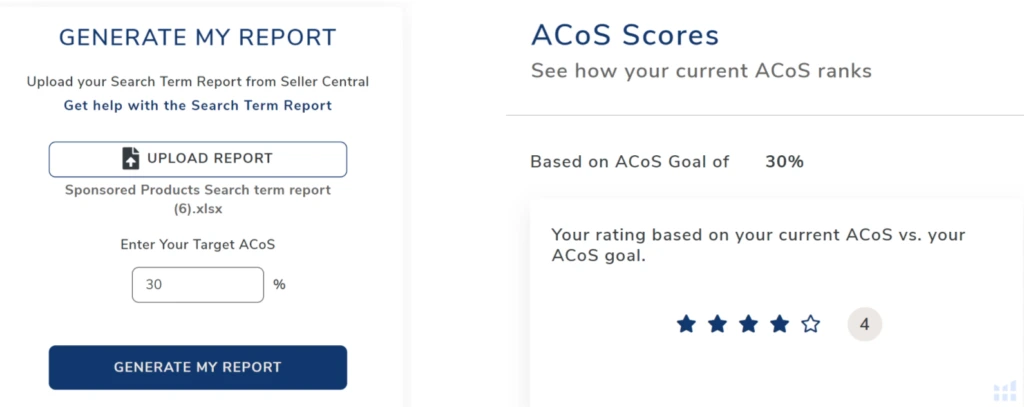
Vince: The first thing you need to do is download your PPC search term report from seller central. Then you can upload it on the PPC audit page of Helium 10, then enter your Target ACoS.

Vince: The next tab in the audit will give you a closer look at the details. First, how many of your campaigns are hitting your target.
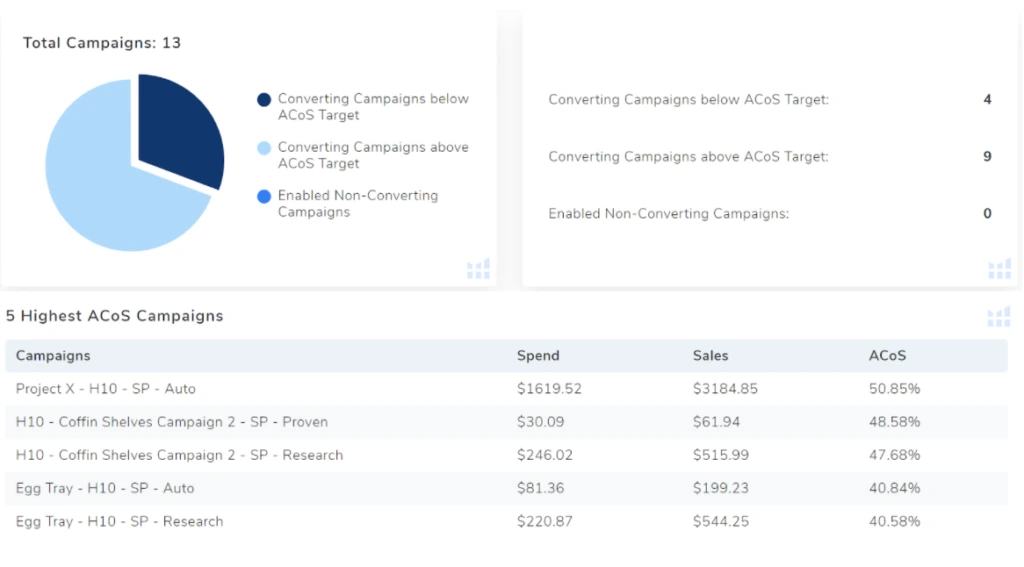
Vince: Next, it shows you your highest ACOS campaigns.
Bradley: Ouch, that coffin shelf auto campaign is kicking my butt at over 50%.
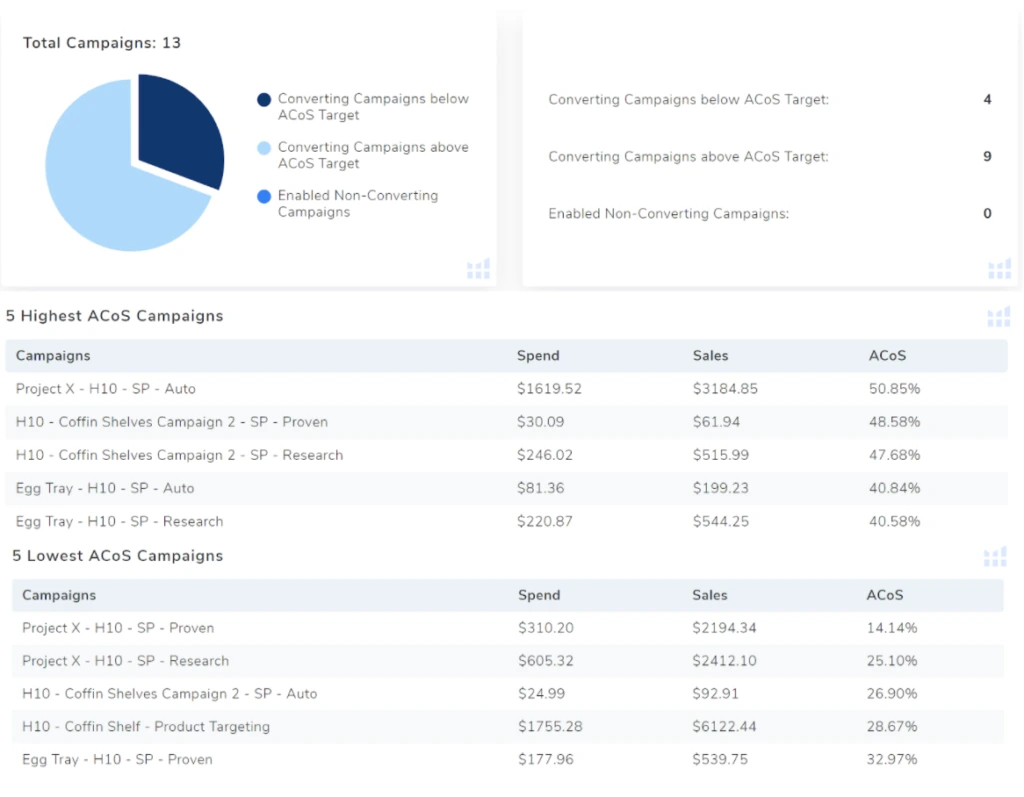
Bradley: Ok, well on the flip side, I seem to have some nice low ACoS campaigns going on. The exact match, coffin shelf campaign looks like it’s at 14%.
Vince: Yup. Pretty good. But the data doesn’t stop there.
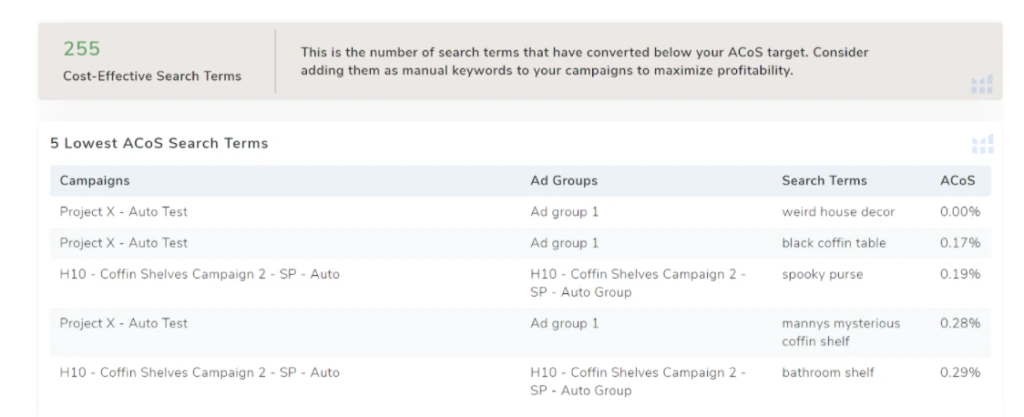
Vince: You have tons of great keywords here! The audit found your top 5 lowest ACoS search terms you can target as keywords if you’re not already.
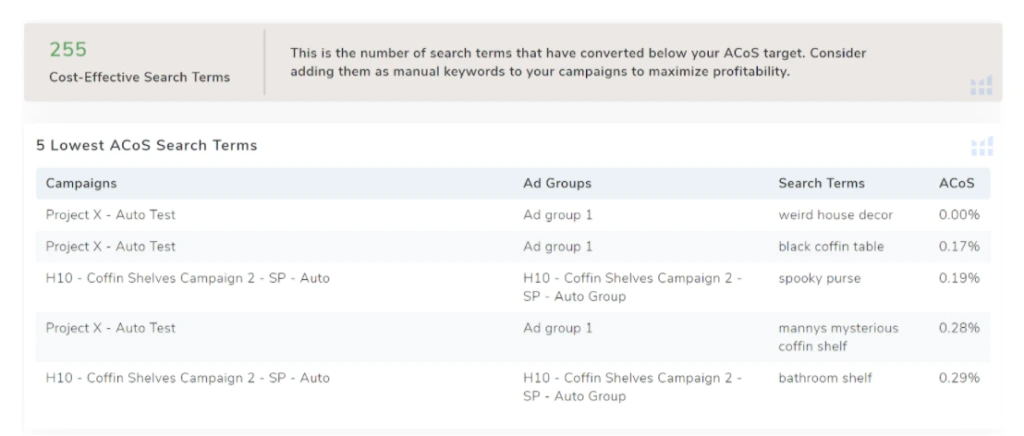
Bradley: Wow. Black coffin table was 0.17% ACoS. Thats insane.

Vince: Here are the worst ones that you haven’t negative-matched yet. Home decor clearance and gothic keywords have almost 200 clicks with ZERO sales!!!
Super Actionable Results
Bradley: Wow, how NOT cool is that? How TERRIBLE is that. This is all super actionable!
Bradley: This audit shows you even more things like how you’re doing with your manual keyword campaigns, where you have duplicate keywords, and more. This absolutely will help those reading this to level up their PPC game. How can they get instant access to this free tool, regardless of if they are a Helium 10 user or not?
Vince: Well, as of today, they can find this at helium10.com/ppc-audit
Here’s how it works.
- Visit https://www-hel10.bundledseo.com/amazon-ppc-audit/
- Watch the intro video
- Upload your 60 day search term report
In these challenging times, Amazon, as well as every other online marketplace is just going to continue to grow. Conventional ways of doing business might be enough to keep your business going, but it takes the ability to adapt, and change with the times to really crush it!
Helium 10 is here to help you every step of the way.
Frequently Asked Questions
Achieve More Results in Less Time
Accelerate the Growth of Your Business, Brand or Agency
Maximize your results and drive success faster with Helium 10’s full suite of Amazon and Walmart solutions.

